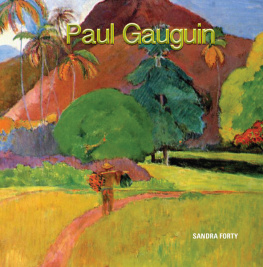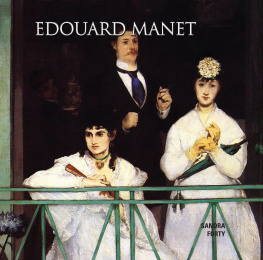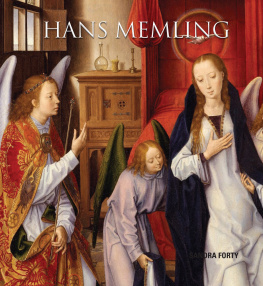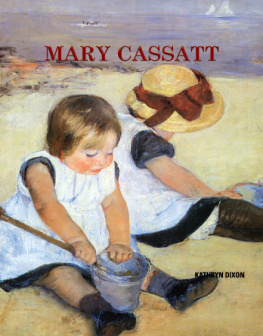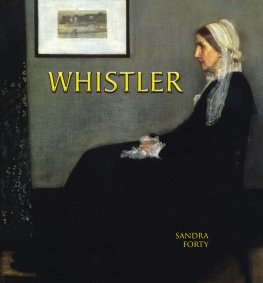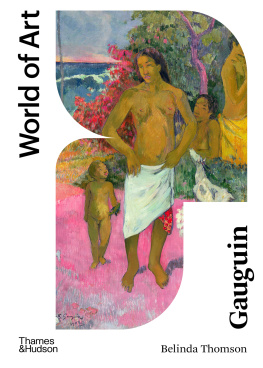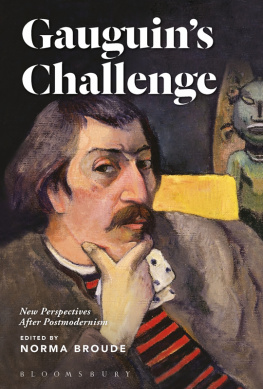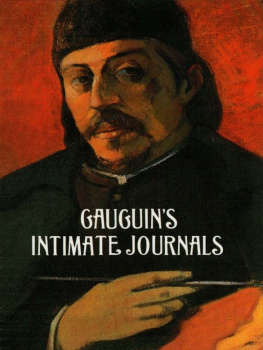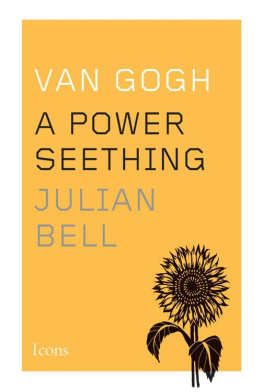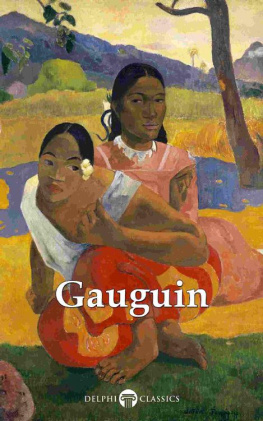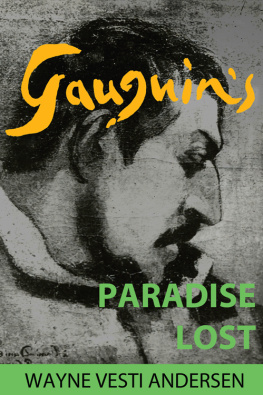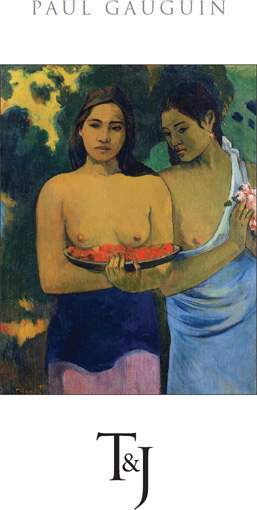Published by TAJ Books International LLC 2013
219 Great Lake Drive
Cary, North Carolina, USA
27519
www.tajbooks.com
www.tajminibooks.com
Copyright 2013 TAJ Books International LLC
All rights reserved. No part of this publication may be reproduced, stored
in a retrieval system, or transmitted in any form or by any means, electronic,
mechanical, photocopying, recording, or otherwise, without the prior written
permission of the Publisher and copyright holders.
All notations of errors or omissions (author inquiries, permissions)
concerning the content of this book should be addressed to
.
ISBN 978-1-84406-256-0
Printed in China
1 2 3 4 5 17 16 15 14 13
1848-1903
G auguin's paintings are redolent of the South Sea islands, full of exotic women, vibrant flora, and brilliant color. In fact, Gauguin was so taken with the Tropics that he spent the last years of his life in French Polynesia, partly for its exoticismhe wanted to paint real savages living an authentic, primitive existenceand partly to escape the taxman and the mundanities of civilized European life.
Now labeled by art historians as a Post-Impressionist, Gauguindead before the term was even coined by the art critic Roger Frycalled himself a Synthesist. His technique was often called Cloisonnisme. It echoed Symbolism in the way that naturalistic representation was abandoned so that a familiar subject was presented as strange and unfamiliar or the unfamiliar was presented as mundane. The intent was to make the observer feel comfortable with the subject but also vaguely uncertain of what was being seen. Gaugin's Vision After the Sermon: Jacob Wrestling with the Angel, painted in 1888, is one of the clearest examples of the genre. This new direction with its anti-mystical subject matter shocked the painter Pissarro, a friend of Gauguin, and when Gauguin offered the painting to a church near Pont-Aven the priest refused it.
Many of Gauguin's later paintings show semireligious symbolism, especially those he painted in Brittany, but his own beliefs were entirely secular. He was interested in primitivism and the unconscious mind, and in Tahiti he was fascinated with local belief systems and customs, many of which were dying out fast, so much so that he often portrayed customs and behavior that had already disappeared.
Eugne Henri Paul Gauguin was born in Paris on June 7, 1848, at 56 rue Notre Dame de Lorette. His father, Clovis Gauguin, was a journalist for the left-wing newspaper Le National and his mother, Aline Marie Chazal, was descended from an influential Peruvian family through her mother, the socialist-feminist writer Flora Tristan. Her family was descended from a long line of Spanish military men, which was their chosen destiny for Gauguin. They already had a daughter, Mari, when Gauguin was born.
Fearing right-wing political change after Napolon III became the president of France, Clovis Gauguin took his family to Peru in December 1849. But Clovis suffered from a weak heart and died during the voyage. His widow and two children (Paul was 18 months) traveled on to Lima to live with her wealthy great uncle Don Pio de Tristan Moscoso and his family in their palatial mansion where they enjoyed a life of luxury and refinement.
While in Peru, Paul's mother collected Inca pots and pre-Columbian pottery and he long remembered her wearing traditional Peruvian costume. Both aspects are cited as being seminal influences in Gauguin's artistic taste. After four years in Lima, when Gauguin was six years old, his mother returned to France, where the family lived with Gauguin's widowed paternal grandfather, Guillaume, and his son, Isidore Gauguin, on Quai Neuf, in Orlans in north central France. Neither Gauguin nor Mari spoke French and they had to learn quickly. Their native tongue, Peruvian-Spanish, remained Gauguin's preferred language all his life. His grandfather died within months of their return and Paul and Mari inherited his estate.

Self-Portrait, 1896
Musee d'Orsay, Paris
Despite the unfamiliarity of his new home, Gauguin adapted well and excelled at school before being sent to board at the nearby Petit Sminaire de La Chapelle Saint-Mesmin. The school's strict Catholic teachings had a life-long impact on the young boy, but not the one intended; Gauguin thanked them for his intellectual development but repudiated their teachings: I believe that it is there that I learned from an early age to hate hypocrisy, false virtues... and to distrust anything that was antagonistic to my instincts and my reason. He also learnt to be introspective and to keep his thoughts to himself.
He was 17 when he signed on to the merchant marine as a pilot's assistant as part of his compulsory military service. In 1860 his mother moved to Paris to work as a seamstress and the following year she opened her own business on the rue de la Chause. Gauguin and Mari lived with her during their vacations and then full time until 1865 when she retired and moved to the village of l'Avenir and then to Saint-Cloud.
Three years later Gauguin became a merchant marine on the Luzitano, which plied the seas between Le Havre in France and Rio de Janeiro in Brazil. Second Lieutenant Gauguin was at sea in the Caribbean when he received the news that his mother had died; she was only 42. She named her close friend, the wealthy Jewish businessman Gustave Arosa, as her children's legal guardian. In early 1868 Gauguin joined the French Navy in Cherbourg as a third class sailor on board the Jrme-Napolon.
In 1871 Gauguin left the navy and moved to Paris to share an apartment with Mari, just around the corner from Arosa and his family; Mari in particular became a virtual member of their family. Thanks to Arosa's connections, Gauguin was employed as a bookkeeper for Paul Bertin's firm of investment brokers at the Paris Bourse. There he met and befriended the fellow trainee and amateur artist Emile Schuffenecker. That December, Arosa introduced Gauguin to a Danish girl, two years his junior, Mette-Sophie Gad. Two years later, in November 1873, they were married in a Lutheran church in Paris.
Around this period Gauguin started painting in his spare time. He had never had any formal art training but set about his hobby with commendable amateur skill. His first paintings were inspired by Corot and the Barbizon School and featured romantic-naturalist subject matter.
He saw the work of the Impressionists and other contemporary artists in the surrounding cafes and galleries and started buying the occasional work. Away from the sedate establishment atmosphere of the Bourse he was attracted by the bohemian character of the artistic quartier, meeting and carousing with the artists he met there. He became particular friends with Camille Pissarro, one of the founding members of the Impressionists, and through him with other artists. Pissarro in particular became his mentor and artistic guide. It became Gauguin's habit to visit Pissarro on Sundays where they painted together in his garden.
In August 1874 Mette gave birth to a son, Emile. In quick succession other children followed: Aline in 1877, Clovis in 1879, Jean Ren in 1881, and finally Paul Rollon (Pola) in 1883. By all accounts their early years together were happy and Gauguin was a faithful and conventional father and loving husband, earning a good living in the city. The couple had a large circle of friends and lived an apparently happy life.

